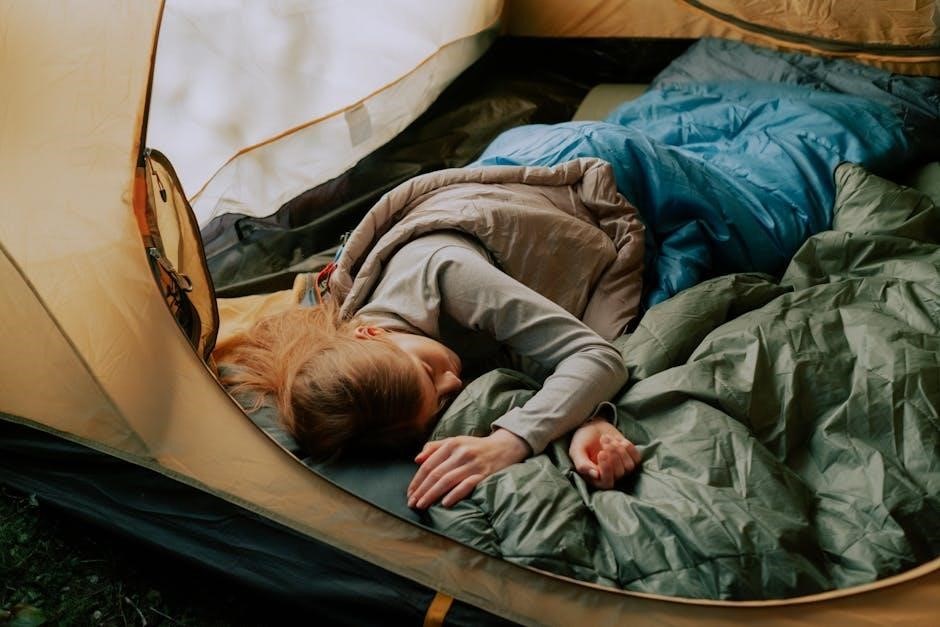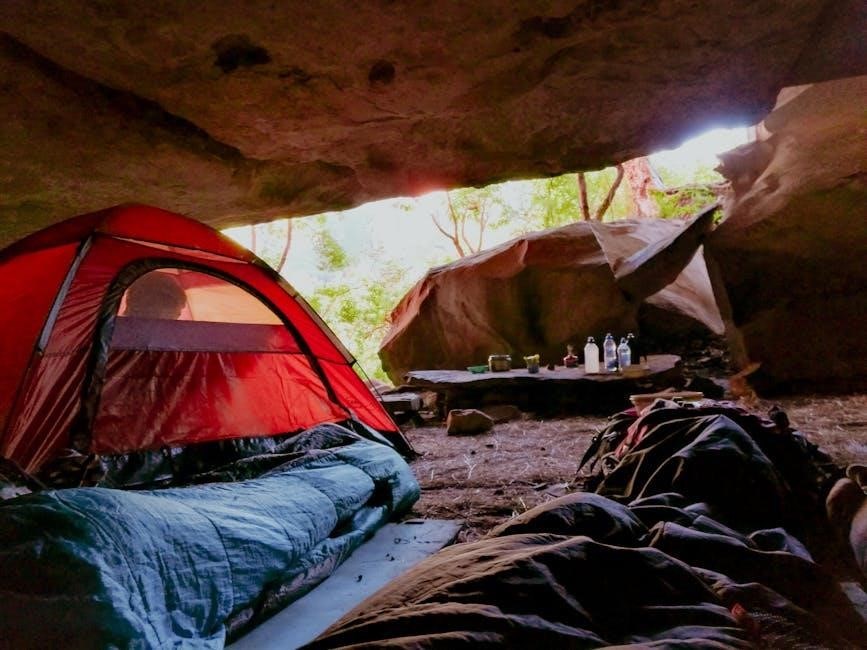Sleeping bag temperature ratings are crucial for campers, defining how warm a bag can keep you in varying conditions. Standardized systems like EN ISO 23537 provide ratings, ensuring safety and comfort.
Understanding the Importance of Temperature Ratings
Sleeping bag temperature ratings are essential for ensuring safety and comfort in outdoor conditions. These ratings indicate the lowest temperature at which a sleeping bag can keep you warm, helping you avoid hypothermia and discomfort. The EN and ISO standards, such as EN ISO 23537, provide a reliable benchmark for measuring a sleeping bag’s performance. By understanding these ratings, campers can choose the right bag for their environment, whether it’s a mild summer night or an extreme winter expedition. Ignoring these ratings can lead to inadequate insulation, putting you at risk of cold-related illnesses. Temperature ratings also guide users in balancing warmth with factors like weight and packability, ensuring optimal performance without compromising mobility. Ultimately, these ratings empower campers to make informed decisions, ensuring their sleeping bag meets their specific needs for a safe and enjoyable outdoor experience.
Overview of EN and ISO Standards for Sleeping Bags
The EN (European Norm) and ISO (International Organization for Standardization) standards provide a consistent method for measuring sleeping bag temperature ratings. These standards ensure that ratings are reliable and comparable across different brands. EN ISO 23537 is the most widely used standard, defining three key temperature thresholds: Comfort, Limit, and Extreme. These ratings are determined through rigorous laboratory tests, simulating real-world conditions to assess how well a sleeping bag retains heat. The Comfort rating indicates the temperature at which an average user will feel comfortable, while the Limit rating is the threshold for survival in cold conditions. The Extreme rating represents the absolute minimum temperature for emergency situations. By adhering to these standards, manufacturers ensure transparency, helping consumers make informed decisions when selecting a sleeping bag for their outdoor adventures. This standardized approach fosters trust and consistency in the industry, benefiting both manufacturers and users alike.
Key Temperature Categories for Sleeping Bags
Sleeping bags are categorized by three main temperature ratings: T Comfort for ideal warmth, T Limit for survival in cold conditions, and T Extreme for emergency situations, ensuring safety and performance.
T Comfort: The Ideal Comfort Range
T Comfort represents the ideal temperature range for a restful night’s sleep, ensuring warmth without excess heat. This rating is typically higher than T Limit, offering a balance between comfort and insulation. For instance, a sleeping bag with a T Comfort rating of -15°C provides optimal warmth for most campers in cold conditions. It’s designed to keep you comfortable during normal camping scenarios, making it suitable for seasonal use. Manufacturers often test this rating under controlled conditions to ensure accuracy. By understanding your typical camping environment, you can choose a bag that aligns with your needs, ensuring a cozy and restful experience. This rating is essential for campers seeking reliability and performance in varying weather conditions.
T Limit: The Threshold for Cold Weather Survival
T Limit denotes the lowest temperature at which a sleeping bag can keep a user warm enough to survive, though not comfortably. It’s a critical rating for extreme cold weather conditions, ensuring safety when temperatures drop drastically. For example, a T Limit of -20°C means the bag can sustain basic warmth at this temperature, but prolonged exposure may cause discomfort. This rating is especially important for high-altitude or Arctic expeditions, where survival depends on adequate gear. Manufacturers often emphasize that T Limit is not for comfort but for emergency situations. By understanding this threshold, campers can make informed decisions about the bag’s suitability for their adventures. This ensures they stay safe in harsh environments, even if comfort is compromised.
T Extreme: The Absolute Minimum for Emergency Situations
T Extreme represents the absolute minimum temperature a sleeping bag can handle in life-threatening conditions. It is the lowest rating, designed for emergency situations where survival is at risk. For instance, a T Extreme of -40°C indicates the bag can provide minimal warmth at this extreme temperature, though not comfortably. This rating is not for prolonged use but serves as a last resort in dire circumstances. Laboratory tests determine this threshold, offering a baseline for extreme cold scenarios. While T Extreme ensures basic survival, it is not intended for regular use. Campers should always aim for a bag with a T Extreme lower than the expected low temperature for their expedition to maximize safety and comfort. Understanding this rating is crucial for adventurers venturing into extreme environments, ensuring they are prepared for the worst-case scenario. This rating underscores the importance of selecting a sleeping bag tailored to the most extreme conditions one might encounter. Always prioritize a bag with a T Extreme that meets or exceeds your needs for ultimate safety.

Factors Influencing Sleeping Bag Temperature Ratings
Fill material, weight, packability, and seasonal use significantly impact temperature ratings. Synthetic vs. down insulation affects warmth retention, while weight influences portability without compromising thermal performance. Seasonal ratings further tailor bags to specific weather conditions, ensuring optimal functionality.
Fill Material: Down vs. Synthetic Insulation
Fill material plays a pivotal role in determining a sleeping bag’s temperature rating. Down insulation, often sourced from European ducks, offers exceptional warmth-to-weight ratios and compressibility, making it ideal for extreme cold. Synthetic insulation, while heavier, retains warmth even when wet, a crucial feature in damp conditions. The choice between the two depends on the environment and activity. For instance, down-filled bags like the Ascent series excel in dry, cold expeditions, providing comfort at temperatures as low as -15°C. Synthetic options, however, are preferred in wetter climates due to their moisture-wicking properties. Both materials are tested under EN ISO 23537 standards, ensuring accurate temperature ratings. The fill power and distribution are carefully measured to maintain consistent warmth, whether in mummy-style bags or lightweight designs. Ultimately, the fill material directly impacts the bag’s performance, durability, and suitability for specific adventures. Balancing these factors ensures the right choice for any camper’s needs.
Seasonal Ratings: Summer, Winter, and Two-Season Bags
Seasonal ratings help categorize sleeping bags based on their suitability for different weather conditions. Summer bags are designed for warmer temperatures, typically rated for comfort in ranges like 0°C to 5°C, making them ideal for spring and summer nights. Winter bags, such as those rated to -18°C or even -40°C, are built for extreme cold and expeditions. Two-season bags offer versatility, bridging the gap between summer and winter needs, providing comfort in moderate to cool conditions. The EN ISO 23537 standard ensures these ratings are consistent and reliable. When choosing a seasonal bag, consider the coldest temperatures you’ll encounter and your personal comfort level. For example, a bag rated to -15°C may be suitable for most winter camping trips, while a -40°C rating is reserved for arctic expeditions. Always select a bag that slightly exceeds your expected needs for safety and comfort.
Weight and Packability: Balancing Warmth and Portability
Weight and packability are critical factors in choosing a sleeping bag, as they determine how easy it is to carry the bag on long hikes or expeditions; Lightweight bags are ideal for backpackers seeking to minimize their load, while warmer, heavier bags are better suited for extreme cold. For example, some ultra-light sleeping bags weigh as little as 30 grams, offering exceptional portability for summer conditions. However, these may not provide adequate warmth for colder climates. Conversely, winter bags with advanced insulation can weigh significantly more but deliver superior warmth. Packability is also influenced by the fill material—down-filled bags are often more compressible than synthetic ones. When selecting a bag, consider your activity level, the length of your trips, and the coldest temperatures you’ll encounter. A balance between weight, warmth, and packability ensures you stay comfortable without being burdened by excess weight. Always evaluate your needs to make the best choice.

How to Choose the Right Sleeping Bag for Your Needs

Choosing the right sleeping bag involves assessing your camping conditions, activity type, and personal preferences. Consider gender-specific designs, seasonal ratings, and understanding standards like EN ISO 23537 for optimal comfort and performance.

Assessing Your Typical Camping Conditions
Understanding your typical camping environment is essential for selecting the right sleeping bag. Consider the average low temperatures, humidity, and wind conditions of your usual camping locations. If you camp in colder climates, prioritize a bag with a lower temperature rating. For milder conditions, a lighter option may suffice. Additionally, think about the season—summer, winter, or shoulder seasons—and whether you need a two-season bag for versatility. Your activity level also matters; high-energy activities may require less insulation, while sedentary camping demands more warmth. Finally, account for personal comfort preferences, as some people sleep colder or warmer than others. By aligning your sleeping bag’s temperature rating with these factors, you ensure a safe and comfortable camping experience. Always aim for a bag rated slightly below your expected low temperatures to account for unexpected cold snaps. Environmental factors like altitude and wind chill should also be considered to maximize performance and safety.
Gender-Specific Designs: Differences in Ratings
Gender-specific sleeping bags are tailored to meet the unique needs of male and female campers, reflecting differences in body heat retention and comfort preferences. Women’s sleeping bags often have higher insulation ratings, as studies show women generally sleep colder than men. They may also feature a more fitted design to reduce cold spots. Men’s bags, while similar, are typically designed with broader shoulder and chest areas to accommodate different body types. Both designs aim to provide optimal warmth, but the specific temperature ratings can vary slightly. For instance, a women’s bag might have a lower T Limit rating for the same activities, ensuring comfort in colder conditions. It’s important to consider these gender-specific features when selecting a sleeping bag to ensure the best fit and performance for your needs. Always check the EN ISO ratings to understand how these designs align with your camping conditions. This attention to detail enhances overall comfort and safety during outdoor adventures.
Understanding the EN 23537 Standard for Accurate Ratings
The EN 23537 standard is a widely recognized testing method for sleeping bags, ensuring accurate temperature ratings. It involves laboratory tests that simulate real-world conditions to determine three key ratings: Comfort, Limit, and Extreme. The Comfort rating indicates the temperature at which an average user will feel comfortable, typically during relaxed camping conditions. The Limit rating represents the lowest temperature at which the sleeping bag can keep a user warm for eight hours without risking hypothermia. The Extreme rating is the absolute minimum temperature the bag can handle, designed for emergency situations where survival is the priority. This standard provides a reliable baseline for consumers, helping them make informed decisions based on their specific needs and the environments they plan to encounter. By adhering to these guidelines, manufacturers ensure their products meet safety and performance expectations. This consistency is invaluable for adventurers seeking reliable gear. Always look for EN 23537 certification when selecting a sleeping bag to ensure accuracy and reliability in temperature ratings.
Maximizing performance and safety with the right sleeping bag requires understanding temperature ratings and choosing gear suited to your needs. Accurate ratings ensure a warm and safe camping experience always.
Final Tips for Selecting and Using Your Sleeping Bag
When choosing a sleeping bag, consider both comfort and extreme ratings to ensure it meets your needs. Opt for a bag with a slightly lower temperature rating than expected to stay warm. Look for EN ISO 23537 certification for reliable ratings. Additionally, consider the fill material—down offers warmth but requires care, while synthetic is more durable. Always check the weight and packability for portability. Gender-specific designs may offer better fit and performance. Finally, use a sleeping pad for extra insulation and stay dry to maintain the bag’s efficiency. By following these tips, you can enjoy a comfortable and safe outdoor experience regardless of the weather conditions.
